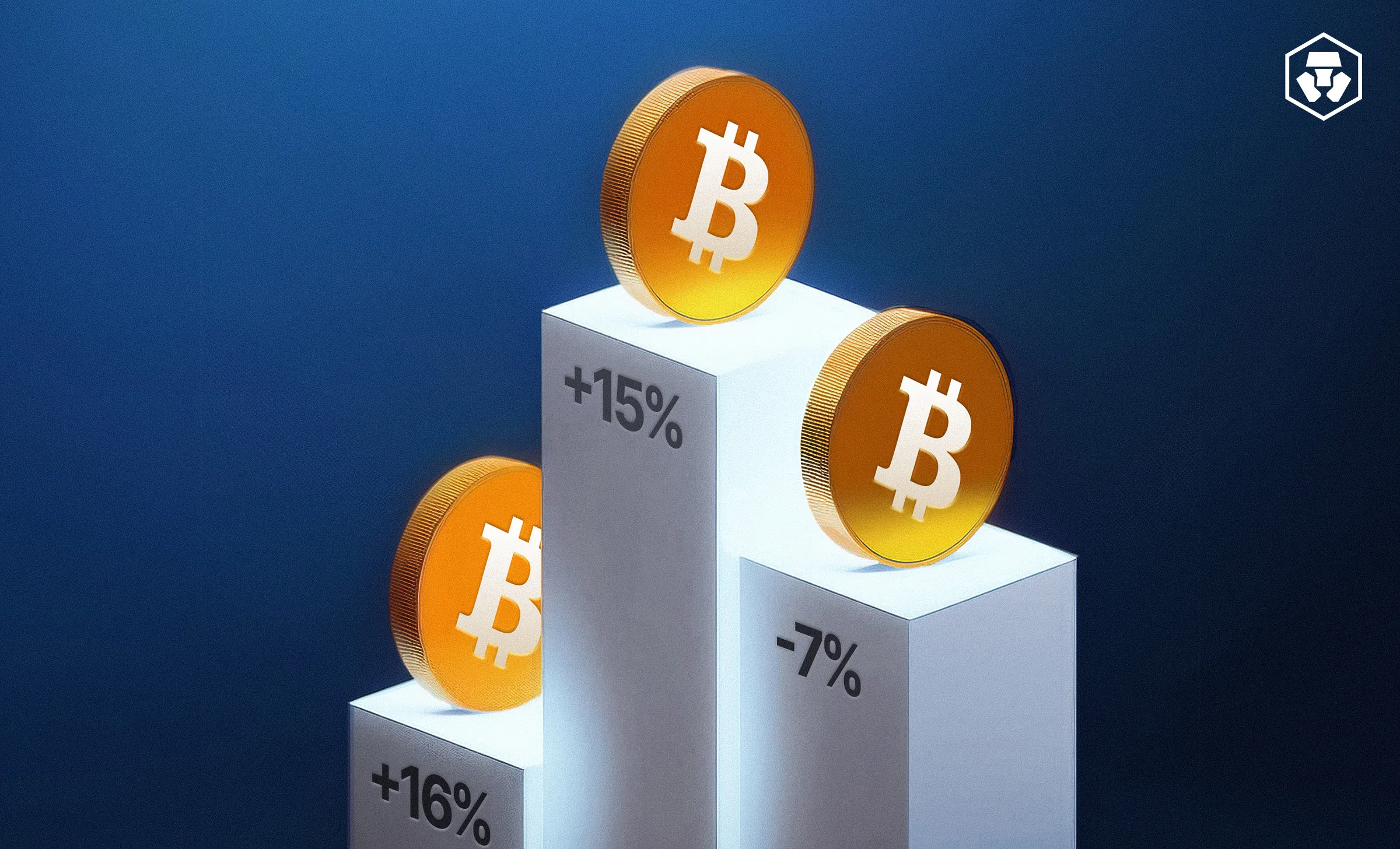
Bitcoin volatility: What causes BTC price swings?
Bitcoin's volatility presents both opportunities and risks. Here’s how price swings can affect Bitcoin trading.
Key Takeaways:
- Volatility in Bitcoin’s price is driven by factors like limited supply, market sentiment, regulatory uncertainty, and technological developments.
- Volatility can be beneficial for short-term traders who can potentially capitalise on rapid price swings, but it also poses risks.
- Strategies like day trading, options trading, and hedging can help traders profit from Bitcoin’s volatility while managing risk.
- Long-term traders may benefit from adopting a 'HODLing' strategy or buying the dip during periods of price decline.
- Understanding market conditions and staying informed about the latest developments are crucial for successfully navigating Bitcoin's volatile market.
Introduction
Cryptocurrencies, including Bitcoin, are known for their price fluctuations.
This article delves into the nature of volatility in the crypto market and discusses the factors that make Bitcoin particularly volatile, while providing strategies for trading Bitcoin with volatility in mind.
What Is Volatility in the Cryptocurrency Market?
Volatility refers to the degree of variation in the price of a financial asset over time. In simple terms, it measures how much the price of an asset swings up and down within a certain period. High volatility means large price movements, while low volatility indicates smaller, more stable price changes.
In traditional financial (TradFi) markets, assets like stocks, bonds, and commodities also exhibit volatility, but it is generally more muted compared to cryptocurrencies. The crypto market is notorious for its high volatility, with price swings often exceeding 5%–10% in a single day. This level of volatility can be both a risk and an opportunity for traders.
Crypto.com shares the weekly volatility index in its Market Pulse updates.
Factors Contributing to Crypto Market Volatility
Several factors contribute to the volatility observed in the crypto market, including market maturity and sentiment, liquidity, and speculation.
- Market Maturity: The cryptocurrency market is relatively nascent, leading to less stability compared to more established markets. With fewer established regulations, less liquidity, and fewer institutional investors than traditional markets, the crypto market can be more prone to sharp price changes.
- Market Sentiment: Cryptocurrency prices are highly sensitive to news, social media, and market sentiment. A single tweet from a notable figure or a regulatory announcement can trigger significant price movements.
- Liquidity: The crypto market, while growing, still has lower liquidity compared to traditional markets. Low liquidity can cause more drastic price changes because fewer buyers and sellers are needed to move the price.
- Speculation: Many traders in the crypto market are driven by speculation rather than long-term investment strategies. This speculative behaviour can lead to rapid price increases followed by sharp corrections.
Learn more about volatility in the crypto market.
Why Is Bitcoin Volatile?
While the entire crypto market is known for price swings, Bitcoin, the first and most well-known cryptocurrency, often leads the pack. Several unique factors contribute to Bitcoin's volatility:
Bitcoin's supply is capped at 21 million coins, creating a scarcity that can drive up demand. This limited supply means that any significant change in demand, whether due to trader interest or macroeconomic factors, can cause substantial price fluctuations. For example, during periods of heightened interest in Bitcoin, such as after positive news or institutional adoption, prices can dramatically surge. Conversely, when interest wanes, prices can drop just as quickly.
Bitcoin's price can be sensitive to market sentiment and news, partly because it operates in a less regulated space than traditional markets, and information spreads rapidly and often uncontrollably. A single piece of news, whether it's a country announcing the acceptance of Bitcoin as legal tender or a major exchange experiencing a hack, can cause massive price movements. The global nature of Bitcoin trading and a 24/7 crypto market mean that events in any part of the world can impact its price at any time.
Governments around the world are still figuring out how to regulate cryptocurrencies, and this regulatory uncertainty is a driver of Bitcoin's volatility. Announcements regarding potential regulation or bans can lead to significant price swings. For example, when China announced a crackdown on cryptocurrency mining and trading, Bitcoin's price sharply dropped. Conversely, news of potential regulation that is seen as favourable, such as the approval of a Bitcoin exchange-traded fund (ETF), can lead to price surges.
The technology underlying Bitcoin is still evolving, and any changes or updates can impact its price. For instance, when there is news about improvements to Bitcoin's scalability or security, it can lead to increased trader confidence and higher prices. On the other hand, concerns about the energy consumption of Bitcoin mining or potential vulnerabilities in its protocol can cause prices to fall.
Due to the relatively low market capitalisation compared to traditional assets, Bitcoin is more susceptible to market manipulation. Large players, often referred to as ‘whales’, can influence the market by making significant trades that cause price fluctuations. Additionally, the presence of unregulated exchanges increases the risk of price manipulation through practices like wash trading or spoofing.
Check out our dive deep on everything Bitcoin at the Bitcoin Hub.
How to Trade Bitcoin With Volatility in Mind
Trading Bitcoin requires a solid understanding of its volatility and strategies to manage the associated risks. Below are key approaches to consider when trading Bitcoin in a volatile market.
Technical analysis involves analysing price charts and using various indicators to predict future price movements. In a volatile market like Bitcoin, technical analysis can be a useful tool for identifying potential entry and exit points. Common indicators used in Bitcoin trading include moving averages (MAs), Relative Strength Index (RSI), and Bollinger Bands. By understanding these indicators, traders can make more informed decisions about when to buy or sell.
New to technical analysis? Learn the fundamentals here.
A stop-loss order is an order placed with a broker to buy or sell once the price of an asset reaches a certain level. In a volatile market, setting stop-loss orders can help protect against significant losses by automatically closing a position if the price moves against the trader's expectations. This is particularly important in Bitcoin trading, where prices can change rapidly.
Here’s how to set stop-loss orders in the Crypto.com App.
Diversification is a key strategy in managing risk in any crypto portfolio. In the context of Bitcoin, this could mean holding a mix of cryptocurrencies, stablecoins, and other assets like stocks or bonds. By diversifying, traders can reduce the impact of Bitcoin's volatility on their overall portfolio.
Dollar Cost Averaging (DCA) is an asset strategy where a trader invests a fixed amount of money at regular intervals, regardless of the price. This approach can help mitigate the impact of volatility by spreading out their purchases over time. In the context of Bitcoin, DCA allows traders to accumulate Bitcoin gradually without worrying too much about short-term price swings.
Given Bitcoin's sensitivity to news and market sentiment, staying informed is crucial. Regularly monitor news related to Bitcoin, such as regulatory developments, technological advancements, and macroeconomic factors. By staying informed, traders can better anticipate potential price movements and adjust their trading strategy accordingly.
Bitcoin's volatility means that trading it can be both highly profitable and highly risky. As such, it's important to be mentally and financially prepared for the possibility of significant losses — as well as gains. Traders should only invest money they can afford to lose and consider setting aside a portion of their profits during bull markets to cushion against potential losses during downturns.
Conclusion
Bitcoin's volatility is a double-edged sword. On one hand, it presents significant opportunities for traders to make substantial profits in a short period. On the other hand, it also poses substantial risks, with the potential for significant losses. Understanding the factors that contribute to Bitcoin's volatility, such as its limited supply, market sentiment, regulatory uncertainty, and technological developments, is crucial for anyone looking to trade or invest in Bitcoin.
For those who choose to trade Bitcoin, employing strategies like technical analysis, setting stop-loss orders, diversifying portfolios, and staying informed can help manage the risks associated with volatility. While the potential rewards of trading Bitcoin are high, it's essential to approach the market with caution and a clear understanding of the risks involved.
In the end, Bitcoin's volatility is a reflection of its nature as an emerging asset class. As the market matures, it's possible that volatility will decrease, but for now, it remains a defining characteristic of Bitcoin and the broader cryptocurrency market. Whether a newcomer or seasoned trader to the world of cryptocurrency, keeping volatility in mind is key to navigating this exciting and dynamic market.
All examples listed in this article are for informational purposes only. You should not construe any such information or other material as legal, tax, investment, financial, cybersecurity, or other advice. Nothing contained herein shall constitute a solicitation, recommendation, endorsement, or offer by Crypto.com to invest, buy, or sell any coins, tokens, or other crypto assets. Returns on the buying and selling of crypto assets may be subject to tax, including capital gains tax, in your jurisdiction. Any descriptions of Crypto.com products or features are merely for illustrative purposes and do not constitute an endorsement, invitation, or solicitation.
Although the term 'stablecoin' is commonly used, there is no guarantee that the asset will maintain a stable value in relation to the value of the reference asset when traded on secondary markets or that the reserve of assets, if there is one, will be adequate to satisfy all redemptions.
Past performance is not a guarantee or predictor of future performance. The value of crypto assets can increase or decrease, and you could lose all or a substantial amount of your purchase price. When assessing a crypto asset, it’s essential for you to do your research and due diligence to make the best possible judgement, as any purchases shall be your sole responsibility.
Table of Contents
Ready to start your crypto journey?
Get your step-by-step guide to setting upan account with Crypto.com
By clicking the Submit button you acknowledge having read the Privacy Notice of Crypto.com where we explain how we use and protect your personal data.
